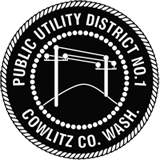
Cowlitz PUD
Energy Efficiency Services
961 12th Avenue
P.O. Box 3007
Longview, WA 98632
(360) 501-9514
(800) 631-1131
Hot Water Safety

From a safety and cost-savings standpoint, lowering the temperature makes a lot of sense. Check out these facts:
Time it takes to produce serious burns:
150º F - 2 SECONDS
140º F - 5 SECONDS
130º F - 30 SECONDS
120º F - 10 MINUTES
To Check and Adjust:
Although some manufacturers set water heater thermostats at 140ºF, most households usually only require them to be set at 120ºF, which also slows mineral buildup and corrosion in your water heater and pipes. Water heated at 140ºF also poses a safety hazard—scalding. Savings resulting from turning down your water heater temperature are based on two components: reduced standby losses (heat lost from water heater into surrounding basement area); and consumption (from water demand or use in your home). Set too high, or at 140ºF, your water heater can produce standby heat loss resulting in energy waste.
• Run hot water at the faucet nearest your water heater.
• Measure the water temperature with a cooking thermometer. If it’s above 120º F, consider turning it down.
• You will need a flat-tip screwdriver and possibly a Phillips screwdriver. We also suggest using gloves, as you will be working around insulation.
• TURN OFF THE ELECTRICITY TO YOUR WATER HEATER PRIOR TO MAKING ANY ADJUSTMENTS. This is done by switching off the appropriate breaker at your electric panel.
• Remove the thermostat access panel(s) and cover(s). Do not remove the plastic protectors covering the thermostats.
• Using a flat tip screwdriver, rotate the adjusting knobs to the desired setting.
• Replace the covers and access panels, and turn on the electrical supply.
Time it takes to produce serious burns:
150º F - 2 SECONDS
140º F - 5 SECONDS
130º F - 30 SECONDS
120º F - 10 MINUTES
To Check and Adjust:
Although some manufacturers set water heater thermostats at 140ºF, most households usually only require them to be set at 120ºF, which also slows mineral buildup and corrosion in your water heater and pipes. Water heated at 140ºF also poses a safety hazard—scalding. Savings resulting from turning down your water heater temperature are based on two components: reduced standby losses (heat lost from water heater into surrounding basement area); and consumption (from water demand or use in your home). Set too high, or at 140ºF, your water heater can produce standby heat loss resulting in energy waste.
• Run hot water at the faucet nearest your water heater.
• Measure the water temperature with a cooking thermometer. If it’s above 120º F, consider turning it down.
• You will need a flat-tip screwdriver and possibly a Phillips screwdriver. We also suggest using gloves, as you will be working around insulation.
• TURN OFF THE ELECTRICITY TO YOUR WATER HEATER PRIOR TO MAKING ANY ADJUSTMENTS. This is done by switching off the appropriate breaker at your electric panel.
• Remove the thermostat access panel(s) and cover(s). Do not remove the plastic protectors covering the thermostats.
• Using a flat tip screwdriver, rotate the adjusting knobs to the desired setting.
• Replace the covers and access panels, and turn on the electrical supply.